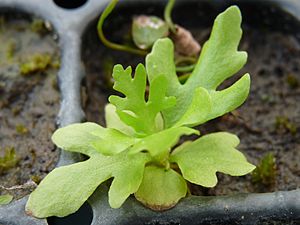Ceratopteris thalictroides facts for kids
Quick facts for kids Ceratopteris thalictroides |
|
|---|---|
 |
|
| Ceratopteris thalictroides, showing typical above-water foliage | |
| Conservation status | |
| Scientific classification | |
| Genus: |
Ceratopteris
|
| Species: |
thalictroides
|
Ceratopteris thalictroides is a type of fern that loves water. It's often called the water sprite or Indian fern. This plant belongs to a special group of ferns called Ceratopteris. It's one of only two kinds in its family, the Pteridaceae, that grow this way.
Contents
What People Call This Fern
This fern has many common names! People often call it the water sprite, Indian fern, water fern, or oriental waterfern. Another name is water hornfern. In the Philippines, it's known as pakung-sungay, which means 'antler fern' or 'horn fern'.
Where Does This Fern Grow?
You can find Ceratopteris thalictroides all over the world in tropical areas. It's a very common plant in many different places.
What Does the Water Sprite Look Like?
This fern usually grows rooted in mud. It can look very different depending on where it lives. The plant's stems, called stipes, can be quite thick in older plants. They are spongy and full of air.
The leaves, called fronds, come in two main types. The sterile fronds are light green and soft. They spread out and can be up to 60 cm long. The fertile fronds are firmer and stand upright. They can grow much longer, sometimes over 100 cm. These fertile fronds are where the fern makes its spores.
Scientists have studied the tiny parts inside the plant, called chromosomes. They found that some types of this fern have 156 chromosomes. Other types have 154 chromosomes. This small difference means they are actually distinct species.
How Does This Fern Live in Nature?
Ceratopteris thalictroides loves wet places. You can find it in swamps, marshes, and natural ponds. It often grows in still water or slow-moving rivers. It prefers full sun to some shade. This fern grows from sea level up to about 1300 meters high. However, it is most common below 500 meters.
Sometimes, you'll see large groups of these ferns floating on logs or other plants. In some areas, the fern grows and releases its spores during the dry season. By this time, it might lose most of its soft, sterile fronds. While it can seem like it lives for only one year in the wild, it can actually live much longer when grown by people.
How Do People Use This Fern?
Eating This Fern
In places like Madagascar, New Guinea, and Vietnam, people cook and eat the fronds of this fern as a vegetable. In Micronesia, they sometimes eat it raw in salads. However, it's important to know that this plant is thought to contain some natural chemicals that might not be good for you.
Other Cool Uses
Ceratopteris thalictroides is very popular as a plant for aquariums. People love it because it's so flexible. You can let it float on the water, or you can root it in the gravel at the bottom.
In the Sepik region of New Guinea, people even use the fronds of this fern as a personal decoration!
How to Grow Your Own Water Sprite
This fern grows best in soil with a pH level between 5 and 9. It also needs a lot of light to thrive. When it has the right conditions, it usually grows very quickly.
Like many water plants, Ceratopteris thalictroides can grow even better if you add CO2 (carbon dioxide) to its water. This fern reproduces in a similar way to other ferns. It grows small new plants, called plantlets, right on the main plant. When these plantlets are ready, they break off and start growing on their own.
Having this fern in an aquarium can be great for fish. Its dense roots help to take nutrients out of the water. This can help prevent unwanted algae from growing. The fern also provides useful shade for shy fish and tiny baby fish.


